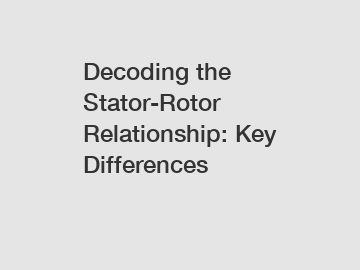Decoding the Stator-Rotor Relationship: Key Differences
Decoding the Stator-Rotor Relationship: Key Differences?
What are the key differences between the stator and rotor in various systems? Understanding the distinctions between these crucial components is essential for many fields, including engineering, physics, and electronics. In this article, we will explore the key differences between the stator and rotor, shedding light on their roles and functionalities. So let's dive in!
1. Definition and Functionality:

The stator is a stationary part of a system, typically found in motors, generators, and transformers. It consists of a fixed frame or housing that holds various coils, windings, or magnets. The primary function of the stator is to generate a magnetic field that interacts with the rotor to produce rotational motion or induce voltage in nearby components.
On the other hand, the rotor, also known as the armature, is the moving part of a system. It is responsible for transforming the energy provided by the stator into rotational motion. The rotor usually houses the conductive windings or magnets and rotates around a central axis. Its movement creates an electromagnetic interaction with the stator, allowing the system to perform its intended function.
2. Structure and Design:
One key difference between the stator and rotor lies in their structural design. The stator is typically made up of a solid frame or housing, which holds the coils or magnets. The arrangement of the windings or magnets can vary depending on the specific system requirements. For instance, in an electric motor, the stator may have multiple coil windings placed around its circumference to produce a rotating magnetic field.
Contrastingly, the rotor typically encompasses a central shaft surrounded by a core, which houses the conductive windings or magnets. The rotor's design must accommodate movement and withstand forces generated during operation. The use of different materials, such as laminations or conductive coils, contributes to optimal performance and efficiency.
3. Energy Conversion:
The stator and rotor work in conjunction to convert energy from one form to another. The stator initiates the process by generating a magnetic field, either through a flux created by electric currents in the coils or by using permanent magnets. This magnetic field provides the necessary force to induce rotational motion in the rotor.
The rotor receives this magnetic force and converts it into mechanical energy or electrical output, depending on the system. In motors and generators, the rotor's movement produces mechanical work that can be used to drive machinery or generate electricity. In contrast, in transformers, the rotor's function is primarily to facilitate energy transfer within the system, inducing voltage in nearby coils.
4. Control and Synchronization:
Another crucial difference between the stator and rotor lies in their control and synchronization mechanisms. In many systems, the stator is the primary component that is externally controlled. The deployment of electrical currents or the manipulation of magnetic fields allows for precise control of the stator's behavior and characteristics.
In contrast, the rotor typically follows the movement initiated by the stator and does not require direct external control. The rotor's motion is generally driven by the interaction with the stator's magnetic field. However, in some systems, such as variable-speed drives, the rotor's speed and position may be controlled for specific operational requirements.
In conclusion, understanding the key differences between the stator and rotor is vital for comprehending the working principles of various systems. The stator acts as the stationary part that generates the magnetic field, while the rotor functions as the moving part that converts this energy into useful work. Each component's structure and design, energy conversion capabilities, and control mechanisms contribute to their unique roles. By decoding the stator-rotor relationship, we can unlock innovations and advancements in numerous industries, benefiting society as a whole.
Want more information on custom stamped stator and rotor cores, custom stamped stator and rotor cores, stator and rotor manufacturer? Feel free to contact us.

Comments
0